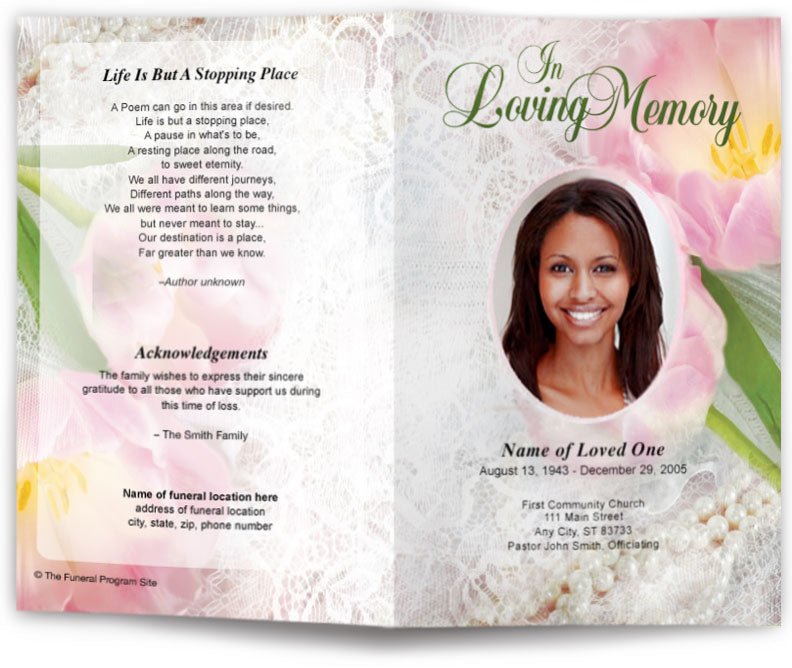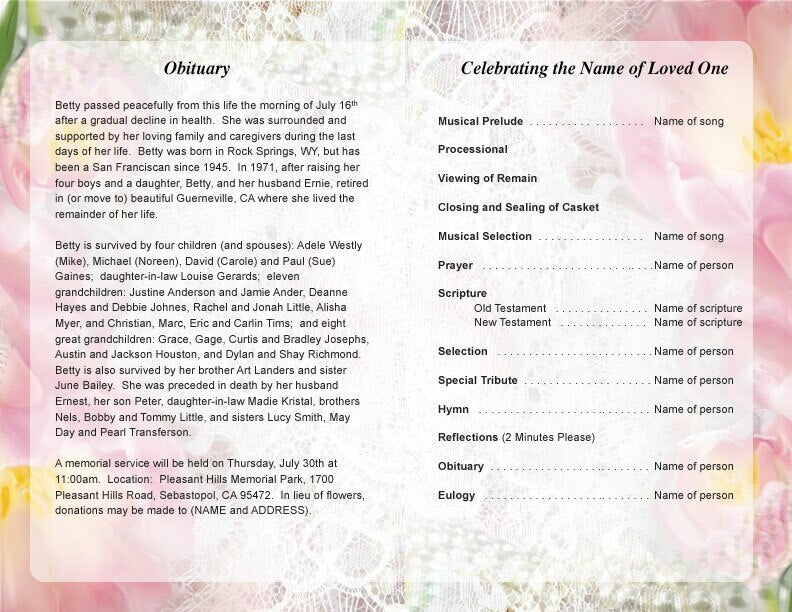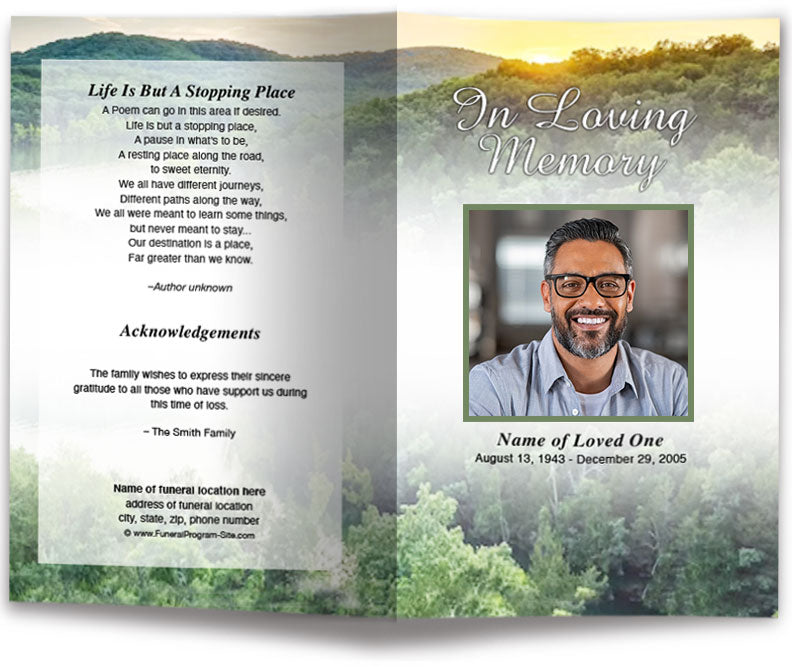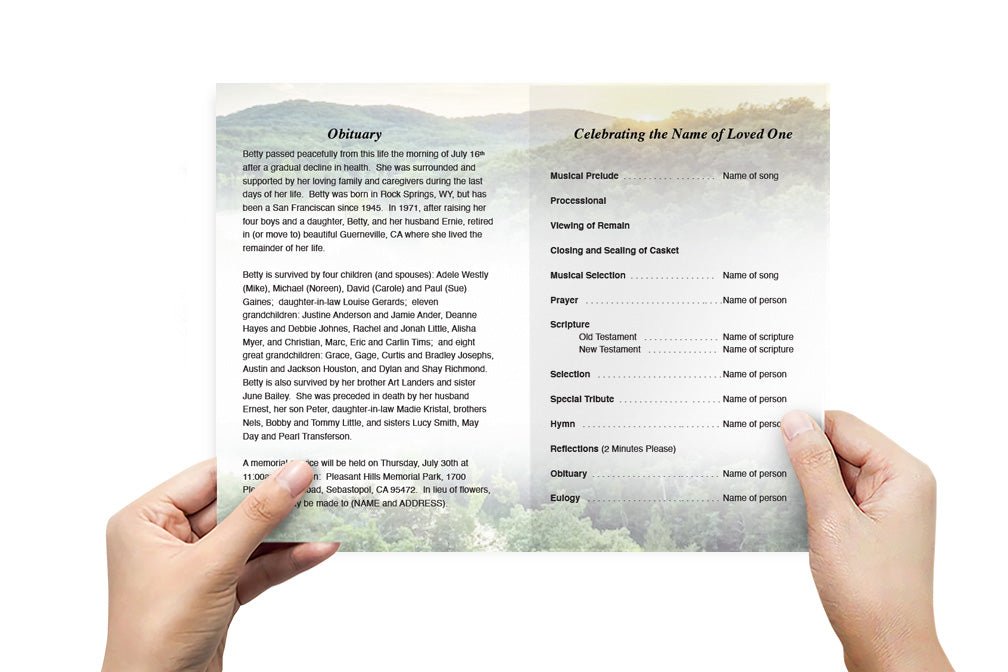How To Personalize A Funeral Program Template

Personalizing a funeral program template allows families to create a unique and heartfelt tribute that captures the spirit and legacy of their loved one. Whether you're working with a bifold, trifold, or graduated fold design, customization ensures the memorial service feels meaningful and personal. A personalized funeral program serves as both a guide for attendees and a cherished keepsake for years to come.
Choose a Meaningful Theme or Design
Begin by selecting a template that reflects the personality, faith, or interests of the departed. Options range from floral backgrounds and religious imagery to hobbies like gardening, fishing, or music. A thoughtfully chosen design sets the tone for the entire program and resonates deeply with attendees. Some templates offer elegant minimalism, while others may be more ornate, featuring decorative borders, vintage styles, or artistic flourishes. Choosing a theme is the first and foundational step in creating a truly memorable funeral program.
Consider Seasonal and Cultural Elements
Incorporating seasonal elements, such as autumn leaves or spring blossoms, can create a timely and comforting visual tone. Cultural motifs that reflect heritage or traditions can add profound meaning, honoring the legacy and ancestry of the deceased. When choosing a theme, think about what imagery or symbols would feel most fitting and respectful.
Add Personal Photos
Photographs provide a powerful visual connection to the person being remembered. Include a cover photo and other meaningful snapshots that reflect different life stages. Group photos, candid moments, and milestone events are ideal additions. Make sure the images are high resolution for print clarity to avoid pixelation or distortion.
Tips for Choosing the Best Photos
-
Select clear, well-lit images that focus on the individual's face.
-
Include a mix of formal portraits and casual, everyday moments.
-
Avoid overly busy backgrounds that may distract from the subject.
-
Consider a photo collage layout for inside pages to showcase more memories.
Write a Heartfelt Obituary or Biography
Most funeral programs include a brief life story or obituary. This can highlight significant achievements, character traits, relationships, and life milestones. Use warm, respectful language to share the essence of the individual’s life journey and values. A well-written obituary not only informs but also celebrates the life lived.
Elements to Include in the Obituary
-
Full name, including maiden or other names
-
Birth and death dates
-
Birthplace and places of residence
-
Educational and career achievements
-
Military service, if applicable
-
Hobbies, passions, and notable talents
-
Family relationships (parents, spouse, children, grandchildren)
-
Contributions to the community or special causes
-
Final message, quotation, or favorite saying
Include Favorite Quotes, Scriptures, or Poems
Incorporating a favorite scripture, spiritual quote, or poem can add comfort and inspiration. Choose verses that held meaning for your loved one or reflect the tone of the memorial service. This section offers solace and reflection for those attending. Selections can be:
-
Bible verses (e.g., Psalm 23, John 14:1-3)
-
Inspirational poetry (e.g., "Do Not Stand at My Grave and Weep")
-
Favorite sayings or personal mantras
Including these touches makes the program deeply personal and emotionally resonant.
Customize the Order of Service
Tailor the program's flow to match the type of service being held. Include details such as musical selections, readings, eulogies, prayers, and special rituals. Ensure that names and titles of speakers, clergy, and performers are accurate and respectful. The order of service provides structure and helps attendees follow the ceremony.
Sample Order of Service Layout
-
Musical Prelude
-
Processional
-
Opening Prayer
-
Scripture Reading
-
Solo or Choir Selection
-
Eulogy
-
Words of Comfort
-
Closing Prayer
-
Benediction
-
Recessional Music
Clearly listing each element ensures that the service flows smoothly and that participants know when they are called upon.
Acknowledge Special Thanks and Condolences
Use a section to express gratitude to family, friends, and service participants. This acknowledgment can include a special thank-you to caregivers, officiants, or anyone who offered support. It's a kind gesture that many recipients appreciate and remember.
Sample Acknowledgment Wording
"The family of [Name] would like to extend heartfelt thanks for your prayers, love, and support during this time. Your kind expressions of sympathy and acts of kindness have been a source of comfort and strength."
Acknowledgments can also invite guests to a reception or repast following the service.
Choose Fonts and Colors with Intention
Select font styles and colors that complement the design and maintain legibility. Script fonts are elegant but should be used sparingly for headers rather than body text. Muted tones and soft contrasts typically work best for a serene and respectful presentation.
Font and Color Tips
-
Use no more than two to three fonts for consistency.
-
Prioritize readability over decorative elements.
-
Consider soft blues, gentle greens, or classic black and white for a traditional look.
-
Ensure enough contrast between text and background.
Add a Final Thought or Message
End the program with a farewell message, prayer, or closing quote. This final section can offer comfort and closure, reinforcing the celebration of a life well lived. Some families also include a line inviting attendees to a repast or gathering afterward.
Ideas for Closing Messages
-
"Until we meet again, may God hold you in the palm of His hand."
-
"Your memory will forever live in our hearts."
-
"Celebrating a life well-lived and a soul well-loved."
Additional Personalization Ideas
Include Hobbies and Interests
If the departed had a passion for gardening, music, travel, or sports, include subtle motifs or imagery related to these interests. For example, a music note border for a musician or a floral frame for a gardener adds a meaningful touch.
Incorporate Family Recipes or Traditions
Some families choose to include a beloved recipe, such as "Grandma's Famous Apple Pie," especially if food and tradition played a big part in their loved one's life. Sharing these elements can evoke warm, shared memories.
Memory Sections
Invite family members or close friends to contribute a short memory, reflection, or tribute. Featuring a few short, heartfelt messages provides a broader view of the individual’s impact on others.
Using Technology for Personalization
QR Codes and Digital Tributes
Modern funeral programs may include QR codes that link to online photo galleries, video tributes, or memorial pages. Adding a QR code to the back of the program allows attendees to explore even more memories at their convenience.
Digital Funeral Programs
In an increasingly digital world, some families opt to distribute funeral programs electronically through email, downloadable PDFs, or dedicated memorial websites. Digital programs can still be deeply personalized and can reach loved ones unable to attend in person.
Common Mistakes to Avoid When Personalizing a Funeral Program
-
Overcrowding the layout with too much text or too many photos
-
Using low-resolution or blurry images
-
Choosing fonts or colors that hinder readability
-
Forgetting to proofread for typos and errors
-
Missing important service details, such as the officiant's name or scripture references
Taking time to review and edit ensures the program is polished and professional.
How To Personalize A Funeral Program Template Conclusion
Personalizing a funeral program template transforms a simple document into a cherished tribute that truly reflects the life and spirit of a loved one. From selecting meaningful themes and high-quality photographs to crafting heartfelt messages and thoughtfully arranged service details, every element contributes to creating a unique and touching memorial. Whether printed traditionally or distributed digitally, a personalized funeral program brings comfort, celebrates memories, and leaves a lasting impression on all who attend.





























